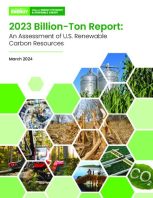
ORNL produces fourth Billion-Ton Report
The report identifies feedstocks that could be available to produce biofuels to decarbonize transportation and industrial processes.
The U.S could triple its current bioeconomy by producing more than 1 billion tons per year of plant-based biomass for renewable fuels, while meeting projected demands for food, feed, fiber, conventional forest products, and exports, according to the Department of Energy’s latest Billion-Ton Report developed by Oak Ridge National Laboratory.
 The latest edition is the fourth in a series of national biomass resource assessments spanning two decades. The report identifies feedstocks that could be available to produce biofuels to decarbonize transportation and industrial processes. The report also examines different levels of market maturity to assess the quantity of biomass that could be produced, its price, geographical density, and distribution. The report covers biomass production capacity from some 60 resources, including winter oilseed crops, trees and brush harvested to prevent forest wildfires, purpose-grown energy crops, macroalgae such as seaweed cultivated in ocean farms, waste captured from cities, and carbon dioxide from industrial plants. Harnessing emerging resources, such as algae, could boost biomass availability by another 250 million tons per year, depending on price, according to the report.
The latest edition is the fourth in a series of national biomass resource assessments spanning two decades. The report identifies feedstocks that could be available to produce biofuels to decarbonize transportation and industrial processes. The report also examines different levels of market maturity to assess the quantity of biomass that could be produced, its price, geographical density, and distribution. The report covers biomass production capacity from some 60 resources, including winter oilseed crops, trees and brush harvested to prevent forest wildfires, purpose-grown energy crops, macroalgae such as seaweed cultivated in ocean farms, waste captured from cities, and carbon dioxide from industrial plants. Harnessing emerging resources, such as algae, could boost biomass availability by another 250 million tons per year, depending on price, according to the report.
Highlights from the report include:
- The U.S. currently uses about 342 million tons of biomass, including corn grain for ethanol and wood/wood waste for heat and power, to meet roughly five percent of America’s annual energy demand.
- The U.S. can triple the production of biomass, producing an estimated 60 billion gallons of low greenhouse gas liquid fuels, while still meeting the projected demand for food, feed, fiber, conventional forest products, and exports.
- Currently available but unused biomass resources can add around 350 million tons of additional biomass per year above current uses and double the U.S. bioeconomy.
- Biomass resources, like energy crops, in a future mature market, can provide more than 400 million tons of biomass per year above current uses.
- Further technological innovations could lead to evolving and emerging resources that represent additional biomass potential.
- The analysis ensures sustainable outcomes by accounting for potential risks to soil, air, and water quality, water availability, and the imperative to protect America’s forests and biodiversity.
Like what you've read?
Forward to a friend!

